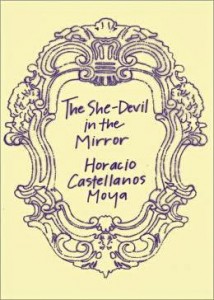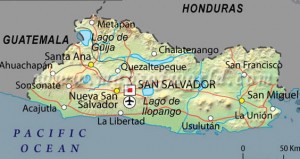“Just look at him, that hypocrite up there saying Mass, as if nothing were wrong. Poor Olga Maria, if she knew that that despicable priest is the one saying her Requiem Mass, she’d die of outrage – I’m sure of it.” –Laura Rivera, narrator.
 With three of his novels now available in English as New Directions translations, Salvadoran journalist and author-in-exile Horacio Castellanos Moya is finally enjoying some of the attention he richly deserves for his focus on human rights abuses under tyrannical governments in Central America. Using different genres for each of these three novels, Castellanos Moya creates dramatically different tones, despite their common settings in Central America, and translator Katherine Silver’s own versatility is obvious as she recreates the different moods. Senselessness (2008), Castellanos Moya’s most powerful and most dramatic novel, conveys the horrors of Mayan genocide in an unnamed country which resembles Guatemala. By contrast, Tyrant Memory (2011) often verges on farce in its satirical depiction of the popular rebellion against a pro-Nazi dictator in El Salvador in 1944, an otherwise serious subject. The She-Devil in the Mirror (2009), also set in El Salvador and the least political of the three novels, is a murder mystery, told as a long monologue by Laura Rivera, a privileged, upperclass woman.
With three of his novels now available in English as New Directions translations, Salvadoran journalist and author-in-exile Horacio Castellanos Moya is finally enjoying some of the attention he richly deserves for his focus on human rights abuses under tyrannical governments in Central America. Using different genres for each of these three novels, Castellanos Moya creates dramatically different tones, despite their common settings in Central America, and translator Katherine Silver’s own versatility is obvious as she recreates the different moods. Senselessness (2008), Castellanos Moya’s most powerful and most dramatic novel, conveys the horrors of Mayan genocide in an unnamed country which resembles Guatemala. By contrast, Tyrant Memory (2011) often verges on farce in its satirical depiction of the popular rebellion against a pro-Nazi dictator in El Salvador in 1944, an otherwise serious subject. The She-Devil in the Mirror (2009), also set in El Salvador and the least political of the three novels, is a murder mystery, told as a long monologue by Laura Rivera, a privileged, upperclass woman.
 Throughout this monologue, Laura confides to an unnamed friend, referred to as “my dear,” quickly grabbing the reader’s attention with her stunned reaction to the news that Olga Maria de Trabanino, her best friend since elementary school, has been murdered. Laura had spent the day with Olga Maria until Olga Maria had to pick up her children at school. Now, only hours later, Olga Maria is dead and Laura is at Olga Maria’s house, where the body remains, covered with a white sheet. In what was apparently a robbery gone wrong, Olga Maria has been murdered in front of her young daughters, one of whom says the killer looked like ROBOCOP.
Throughout this monologue, Laura confides to an unnamed friend, referred to as “my dear,” quickly grabbing the reader’s attention with her stunned reaction to the news that Olga Maria de Trabanino, her best friend since elementary school, has been murdered. Laura had spent the day with Olga Maria until Olga Maria had to pick up her children at school. Now, only hours later, Olga Maria is dead and Laura is at Olga Maria’s house, where the body remains, covered with a white sheet. In what was apparently a robbery gone wrong, Olga Maria has been murdered in front of her young daughters, one of whom says the killer looked like ROBOCOP.
 Taking charge, Laura helps pick out a black satin dress for Olga Maria to wear for the wake and funeral, “very elegant…her prettiest dress,” along with her jewelry and “the right makeup,” then arranges for her hairdresser to do Olga Maria’s hair in her favorite style. Later, at the wake, she asks her companion, “Don’t you think she looks gorgeous, they did a good job on her, you can barely even see the hole in her head.” Making herself indispensible, Laura tries to protect Olga Maria’s children, has advice for the police, provides information for the person she is addressing (including the reader) about Olga Maria’s marriage, and suggests that Olga Maria may have been attracted to one of her husband’s new employees, a handsome photographer she refers to as “Julio Iglesias.” Throughout, Laura provides snide commentary about all the members of the social set to which she and Olga Maria belong.
Taking charge, Laura helps pick out a black satin dress for Olga Maria to wear for the wake and funeral, “very elegant…her prettiest dress,” along with her jewelry and “the right makeup,” then arranges for her hairdresser to do Olga Maria’s hair in her favorite style. Later, at the wake, she asks her companion, “Don’t you think she looks gorgeous, they did a good job on her, you can barely even see the hole in her head.” Making herself indispensible, Laura tries to protect Olga Maria’s children, has advice for the police, provides information for the person she is addressing (including the reader) about Olga Maria’s marriage, and suggests that Olga Maria may have been attracted to one of her husband’s new employees, a handsome photographer she refers to as “Julio Iglesias.” Throughout, Laura provides snide commentary about all the members of the social set to which she and Olga Maria belong.
Laura herself is divorced from Alberto, her husband of eleven months, a successful man whom she considers terminally boring. Gradually, through Laura, the reader discovers just how many affairs Olga Maria has had, with Laura often providing cover for her so that Olga Maria can get away for trysts without endangering her marriage to Marito, owner of an advertising agency, a man to whom she is “totally devoted.” Olga Maria has a short attention span and an almost complete lack of commitment during these extracurricular activities, however, and her lovers are often devastated when she “says goodbye,” sometimes pursuing her, which is a “great annoyance.” On one occasion, in an effort to encourage a lover to leave the country and return to the United States as soon as possible, she even plans a surprise “going-away party” for him, inviting virtually all his friends. Embarrassed, he seeks consolation at the beach at San Blas before departing for Boston.

The surf at San Blas, El Salvador
The novel consists of nine chapters, each of which is one long paragraph. Fortunately, the reader quickly forgets the gray pages of margin-to-margin type, with no indentations and no dialogue to break up the monotony of the type pattern, as Laura’s point of view becomes more and more compelling. Her chatty and unreservedly gossipy commentary is full of revelations about the characters and provides insight into her own life, and her remarks on completely irrelevant subjects are often highly ironic in the contexts in which they are made, providing dark humor throughout the novel. On her way to Olga Maria’s burial after the funeral, for example, Laura expounds on the lack of air-conditioning in churches and the fact that “if those priests installed air conditioning, I swear we’d come to church more often.” Her biggest concern going to the burial is that “for a moment there I was sweating so much I thought my makeup would run.” She then inexplicably reminisces about the red BMW she received as a high school graduation present, years ago, about the succession of BMWs she had had since then, and then jumps to the story of a shooting by terrorists which occurred on the way to her high school graduation party. Ten “gringos” were killed, but her biggest memory of that event is of “how hot two of those gringos were,” something she and Olga Maria investigated further by inspecting the “ten of them sprawled out on the floor, bleeding like pigs. Dreadful, really gruesome.”
 As Laura continues to comment on her best friend’s murder and its aftermath, she blames the lack of progress in the investigation on the ineffective police, the tainted legal system, and the hypocritical clergy, among others, while also providing motives for half a dozen people in her social set to have committed the murder – involvement in a drug cartel, financial misappropriations, unexpected bankruptcy, thwarted love, and political rivalries, to name a few. Castellanos Moya’s pacing is flawless as he suggests but does not always confirm the reader’s conclusions about these characters as described by Laura, and the novel’s finale is memorable, perfectly in keeping with tone and character. The details and subject matter are universal, rather than specific to El Salvador, and readers from around the world will be entertained and often amused by Castellanos Moya’s foray into noir fiction.
As Laura continues to comment on her best friend’s murder and its aftermath, she blames the lack of progress in the investigation on the ineffective police, the tainted legal system, and the hypocritical clergy, among others, while also providing motives for half a dozen people in her social set to have committed the murder – involvement in a drug cartel, financial misappropriations, unexpected bankruptcy, thwarted love, and political rivalries, to name a few. Castellanos Moya’s pacing is flawless as he suggests but does not always confirm the reader’s conclusions about these characters as described by Laura, and the novel’s finale is memorable, perfectly in keeping with tone and character. The details and subject matter are universal, rather than specific to El Salvador, and readers from around the world will be entertained and often amused by Castellanos Moya’s foray into noir fiction.
Note: Author Horacio Castellanos Moya, born in Honduras, raised in El Salvador, and exiled from much of Central America, has been resettled in the United States under a program of The City of Asylum in Pittsburgh, which “provides sanctuary to writers exiled under threat of death, imprisonment, or persecution in their native countries.” (American author Russell Banks was President of this organization for many years.) Castellanos Moya is now an Assistant Professor in the Department of Spanish and Portuguese at the University of Iowa.
ALSO by Horacio Castellanos Moya: SENSELESSNESS , TYRANT MEMORY, and THE DREAM OF MY RETURN
Photos, in order: The author’s photo appears here: http://clas.uiowa.edu
One of Olga Maria’s daughters claims that her mother’s killer looked like ROBOCOP. The RoboCop poster is from http://herocomplex.latimes.com
San Blas in El Salvador may be seen on http://www.wannasurf.com
The map of El Salvador is found here: http://www.mapsofworld.com
